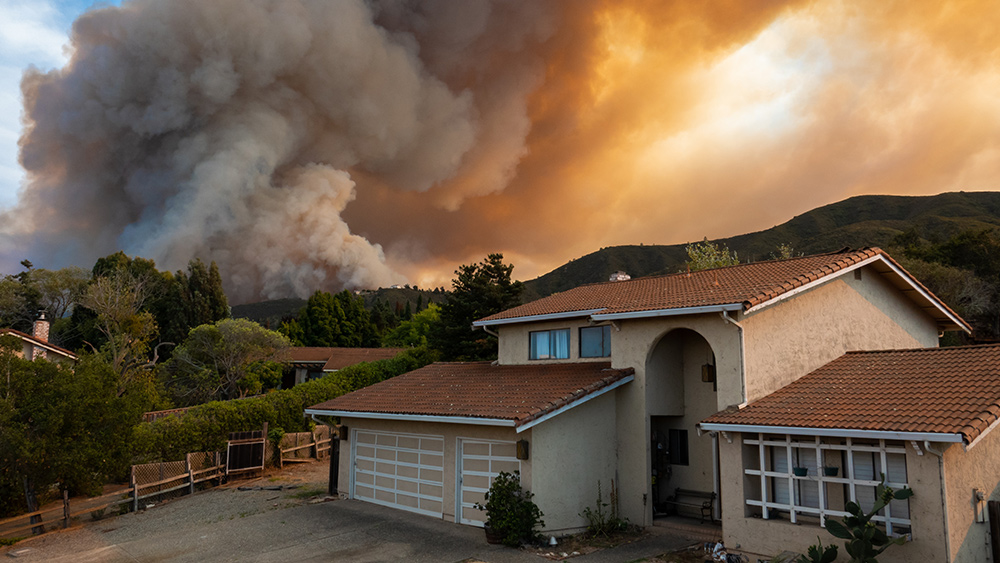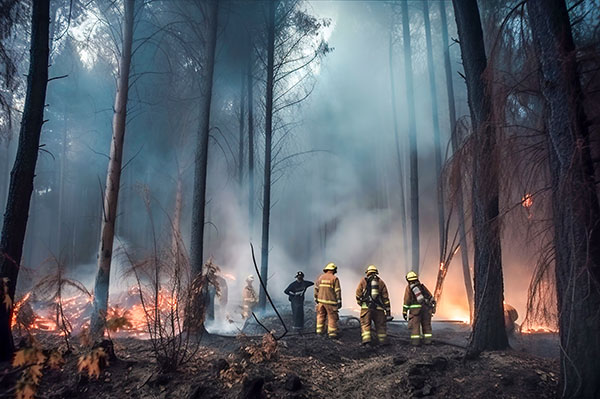Canadian wildfire smoke continues to affect air quality in US cities
06/22/2023 / By Zoey Sky

Reports show that Canadian wildfire smoke continues to affect the U.S., which makes air quality reach unhealthy levels in major cities. Last week, the smoke from the Canadian wildfires affected the Midwest.
The smoke started moving into Minnesota, North Dakota and South Dakota earlier in the month, and the wind had carried high-altitude smoke south into cities like Oklahoma and all the way east into Pennsylvania and New York City. The thickest smoke from the Canadian wildfires stretched from southern Minnesota to Central Ohio.
The National Oceanic and Atmospheric Administration’s (NOAA) Geostationary Operational Environmental Satellite (GOES)-EAST weather satellite spotted the widespread smoke from space right between severe weather over the Gulf Coast states and a low-pressure system seen over the Great Lakes.
There were also reports that hints of smoke were spotted in New Jersey and North Carolina.
Plume Labs, an air quality company owned by AccuWeather, reported last week that air quality was at “very unhealthy” levels in Minneapolis. The air quality company also warned that health effects will be “immediately felt by sensitive groups and should avoid outdoor activity.” Plume Labs also cautioned that even healthy people may “experience difficulty breathing and throat irritation.” (Related: Smoke from Canadian wildfires darkens skies, triggers health warnings for millions.)
The Chicago skyline was also obscured by haze on the morning of June 15, with air quality predicted to worsen as wildfire smoke is expected to drift over the Midwest.
Experts warn that in the following weeks, unhealthy air quality levels may reach as far east as Cleveland.
But conditions are not currently expected to be as extreme as areas farther west in northern Illinois and eastern Iowa.
Experts expect a similar smoky scene for the Ohio Valley and Northeast as a whole, with most of the smoke remaining higher in the atmosphere. This will result in hazy conditions, but air quality could still reach “elevated levels that can be hazardous for sensitive groups.”
The high-altitude smoke will be more conducive for vivid sunsets, compared to the low-level smoke which is usually too thick for the colorful and smoky side effect.
What to do as Canadian wildfire smoke moves across the US
As smoke from wildfires in Canada continues to move into parts of America, millions of people in the Northeast, Mid-Atlantic, Midwest and parts of the Southeast continue to receive air quality alerts of varying levels.
According to reports, at least 13 states have issued air quality alerts due to the thick smoke and fine particles in the air which are dangerous to breathe.
How to protect your family
Always follow the advice of local officials regarding the air quality where you live and work.
According to the Centers for Disease Control and Prevention (CDC), wildfire smoke is a hazardous combination of gases and fine particles that can make anyone sick. Those with asthma, chronic obstructive pulmonary disease (COPD), heart disease, pregnant women, children and responders are especially at risk.
Breathing in the smoke can cause almost immediate effects that include:
- Asthma attacks
- Being tired
- Chest pain
- Coughing
- Difficulty breathing
- A fast heartbeat
- Headaches
- Irritated sinuses
- Runny nose
- Scratchy throat
- Stinging eyes
- Wheezing
If your area is affected by Canadian wildfire smoke, try to keep the smoke outside.
Keep all windows and doors closed. Choose one room that you can close off from outside air.
Use fans and air conditioning to help your family stay cool.
Set up a portable air cleaner or a filter to keep the air in the selected room clean even if it’s smoky in the rest of your home and outdoors.
If you need more light in the room, avoid using candles.
If you are going to cook, avoid using gas, propane or wood-burning stoves. Don’t fry or broil meat.
Avoid using fireplaces or aerosol sprays, and don’t smoke tobacco products or vacuum.
If you have a central air conditioning system in your home, use high-efficiency filters to capture fine particles from the smoke. And if your system has a fresh air intake, set the system to recirculate mode or close the outdoor intake damper.
For rooms with a window air conditioner, check if the seal between it and the window is tight and try to close the outdoor air damper. For window air conditioning units, try running them on fan mode. This will not bring in outside air, but instead circulate the air inside your home.
If you are driving on a stretch of road with poor air quality, set the air to recirculate.
When dealing with poor air quality due to the aftermath of the Canadian wildfires, watch out for any adverse effects if you or someone at home has asthma or heart disease. Get medical help immediately if someone is feeling poorly.
Watch the video below to see NYC covered in wildfire smoke from Canada.
This video is from the High Hopes channel on Brighteon.com.
More related stories:
Canadian officials warn: Wildfire smoke spreading across North America could last all summer.
Ways to keep indoor air clean when there’s wildfire smoke in your area.
Canadian wildfire smoke blocking sun, causing solar panels to produce 50% less energy.
Sources include:
Submit a correction >>
Tagged Under:
air quality, big government, Canada, chaos, Chicago, dangerous, disaster, ecology, environment, fire, Minneapolis, national security, New York, New York City, panic, particulate matter, prevention, SHTF, tips, wildfires
This article may contain statements that reflect the opinion of the author
RECENT NEWS & ARTICLES
COPYRIGHT © 2018 PANIC.NEWS
All content posted on this site is protected under Free Speech. Panic.news is not responsible for content written by contributing authors. The information on this site is provided for educational and entertainment purposes only. It is not intended as a substitute for professional advice of any kind. Panic.news assumes no responsibility for the use or misuse of this material. All trademarks, registered trademarks and service marks mentioned on this site are the property of their respective owners.


















